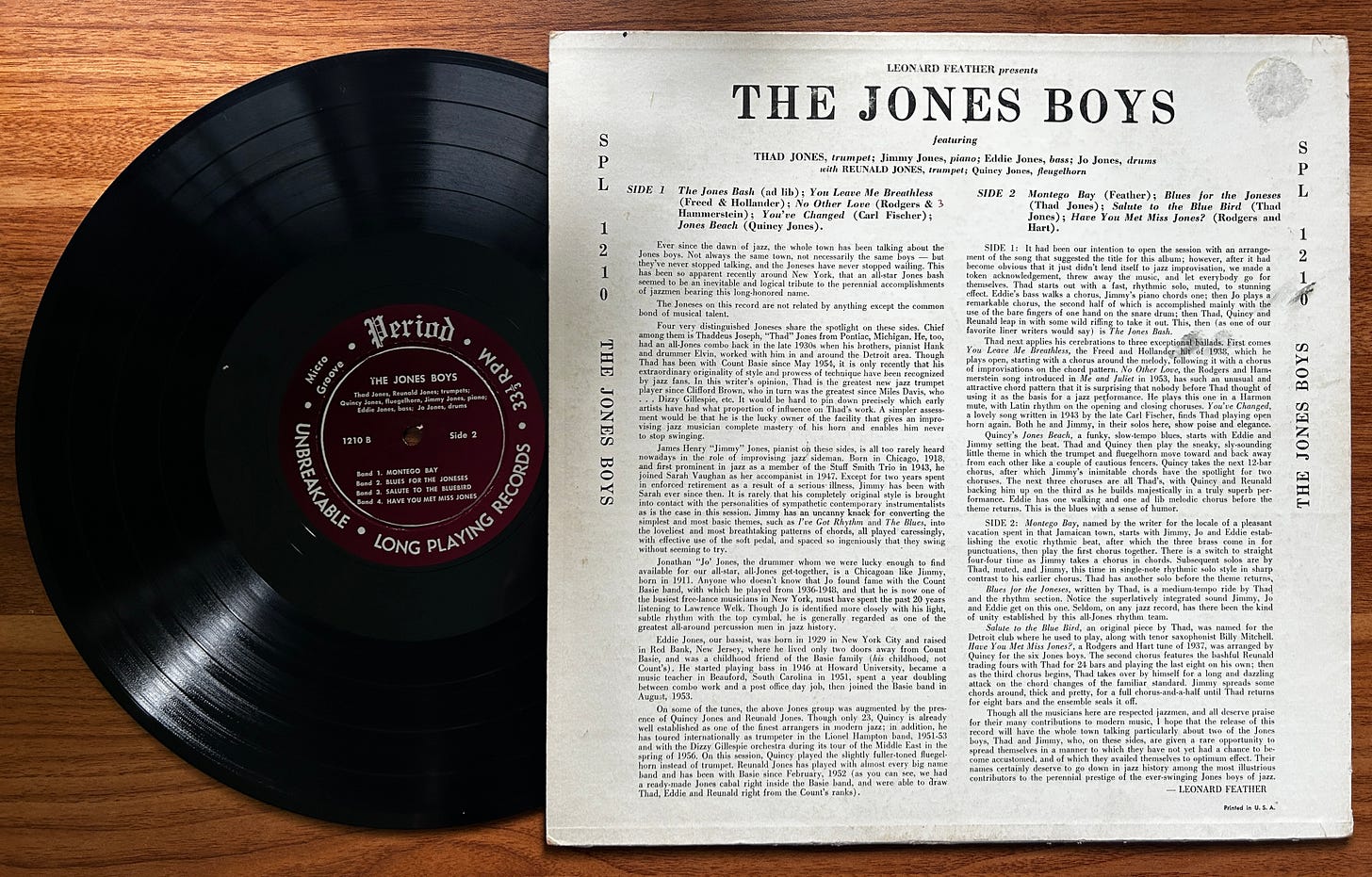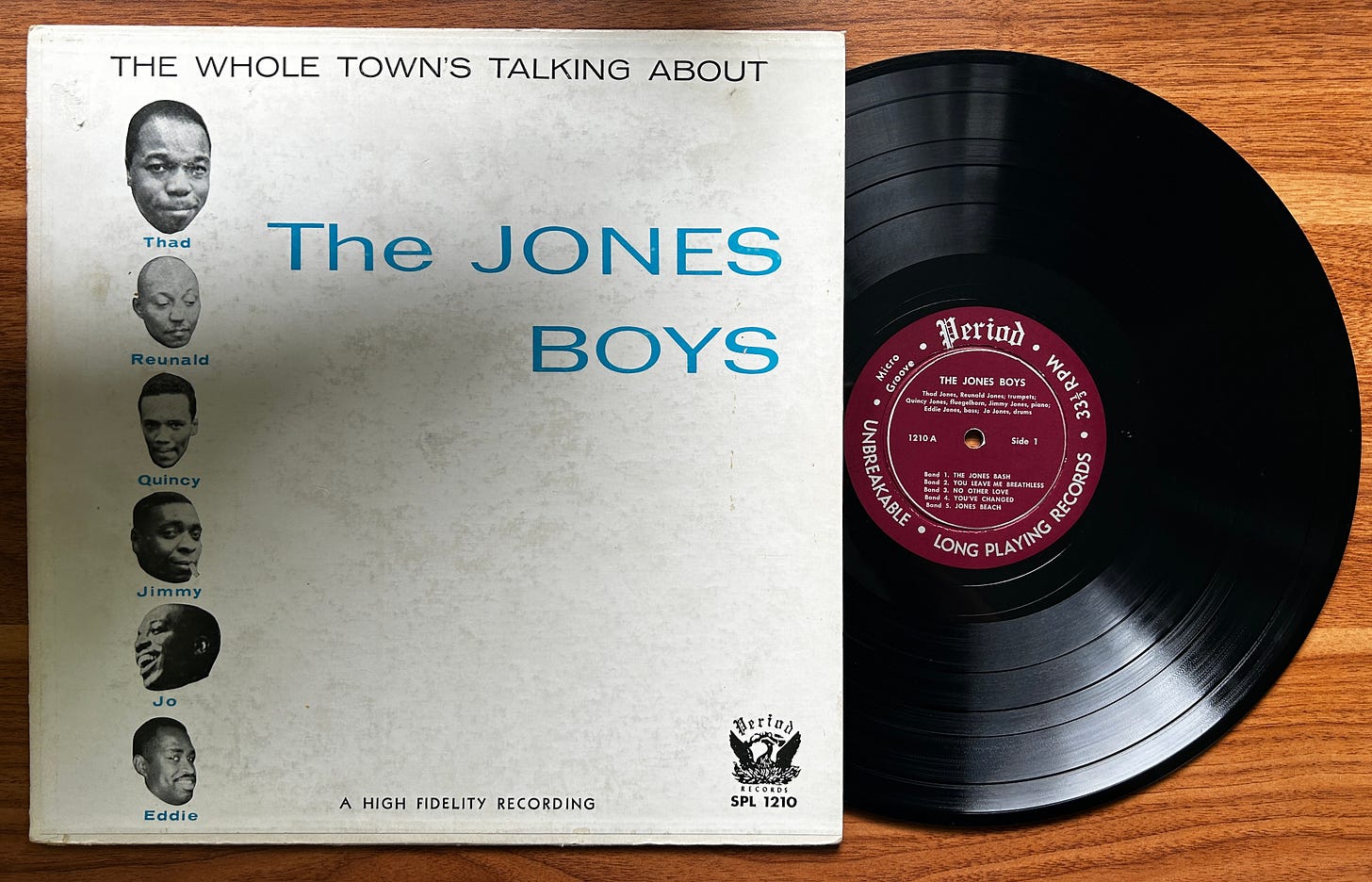The Jones Boys: A Forgotten Gem from Period Records
How Leonard Feather, Jerry Newman, and a standout lineup led by Thad Jones captured one of the most compelling jazz sessions of the 1950s.
As readers of this Substack know, I’ve been immersed in 1950s jazz recordings, digging into the early 10-inch LP format, exploring small artist owned labels, and it’s been a rewarding journey that’s taken me to Paris, Tokyo, and deep into the catalogs of overlooked and forgotten labels like Esoteric, Nocturne, and the one I want to talk about today: Period Records.
Founded in the late 1940s by William Avar and managed by Frank Stevens, Period Records wasn’t originally a jazz label at all. But in the 50’s, jazz critic and producer Leonard Feather played a crucial role in shaping its jazz output. Born in London, Feather moved to the U.S. and quickly became one of jazz’s most prolific chroniclers, not just writing about the music but producing it, curating it, and helping shape how it was heard. At Period, Feather curated a selection of jazz sessions that stood out for their modern style and fidelity.

I explored every Period jazz title I could find online. A few standouts emerged: the Al Haig Quartet record is a solid swing date, and the Birdlanders pulled me in for another reason. These were actually sessions originally produced by Henri Renaud in the U.S. for the French Vogue label, issued as 10" records (and the subject of my last Substack!). But the title that really stood out was The Jones Boys.
This was just a fantastic session from top to bottom. A simple concept: six musicians with the surname Jones and features a stellar lineup: Quincy Jones (arranger and conductor), Jo Jones on drums, Eddie Jones on bass, Jimmy Jones on piano, Thad Jones on trumpet, and Reunald Jones as the guest. But finding a copy wasn’t easy. Only a VG copy without a cover was listed on Discogs in the U.S. Eventually, I tracked down a VG+ copy in Australia. I negotiated with the seller, made a deal, and a few weeks later, the record arrived.

This session doesn’t disappoint. And although everyone’s contribution is exceptional, it is Thad Jones that truly stands out. His trumpet solos are on par with the work he did for Blue Note the year before on albums like The Magnificent Thad Jones, Volume 3, and Detroit–New York Junction. To me, his playing bridges the swing-era with the modern phrasing that defines hard bop. There’s joy and fire in his lines, and a kind of conversational phrasing that feels completely alive.
And then there’s the sound. The album was recorded by Jerry Newman, best known for his 1941 tapes of Charlie Christian at Minton’s, but who by the 1950s had become a serious engineer in the hi-fi scene. His East 26th Street studio, first Esoteric, later called Stereo Sound Studios, was housed in a converted stable with remarkably good acoustics. Newman built his own tube console, recorded on Ampex 350-2 tape decks, and used a minimalist mic setup. From what I could determine, he used a Neumann U47 on horns and bass, RCA 77-DX ribbons on drums, and an Altec or Western Electric mic on piano. And then there’s the pressing, Plastylite handled the original run. The result is a record that holds its own with my favorites from 1957.
This whole exploration of the 1950s has given me a foundation in the music, players, producers, engineers, and the context that shaped these records. It’s helped me understand how this great music was loved, recorded, and shared. But I can feel myself already moving on. Lately, I’ve been seriously diving into the CD era, starting in the 1980s, a time when a number of artists began building onto the early compositions of Monk, Tristano, Parker, Powell, and others. It’s a new kind of search, but with the same spirit of discovery. Stay tuned.
Sources
Liner notes from The Jones Boys (Period SPL-1106), written by Leonard Feather
Discogs listing and sales history for The Jones Boys and other Period titles
Tom Lord Jazz Discography for session details and personnel
Feather, Leonard. The Encyclopedia of Jazz (various editions for background)
Blue Note Records discography for Thad Jones sessions (1956)
“Charlie Christian at Minton’s” recordings by Jerry Newman, personal notes and prior Substack article
Esoteric/Stereo Sound Studios and Plastylite pressing research via Hoffman forums and LondonJazzCollector
Substack post: “French Vogue and the 10-Inch Legacy” for context on Henri Renaud’s productions



